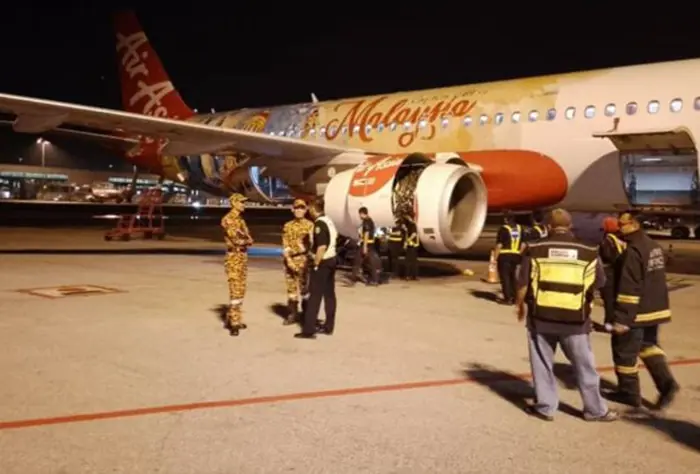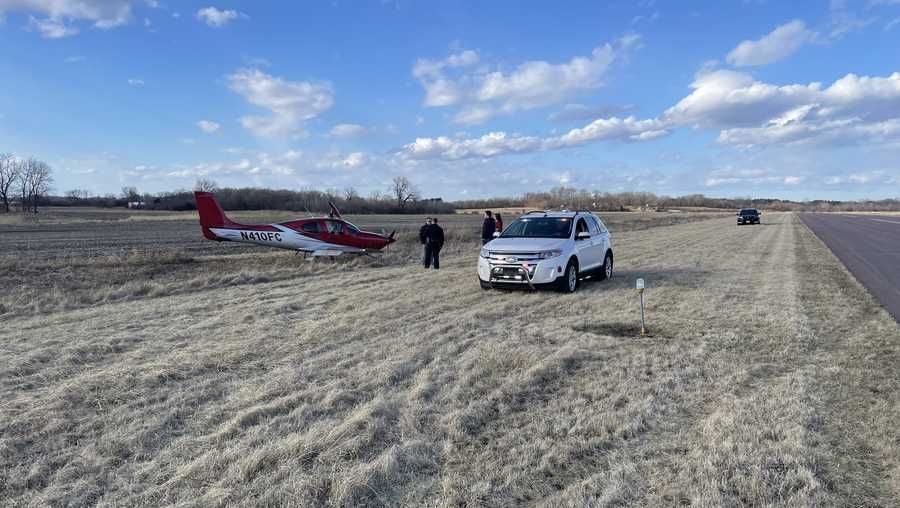ARFF Daily News
Published on:
Thursday the 27th of March, 2025
AirAsia flight makes safe emergency landing at KLIA 2 after engine fire
The Star
SHAH ALAM: An AirAsia flight bound for Shenzhen, China, had to make a turnback to Kuala Lumpur International Airport 2 (KLIA 2) shortly after takeoff due to a reported engine fire.
Selangor Fire and Rescue Department (JBPM) assistant director (Operations) Ahmad Mukhlis Mukhtar said the department was alerted about the emergency landing at 10.37pm on Wednesday (March 26) and dispatched a Fire Rescue Tender vehicle with nine personnel to the scene.
He said that flight AK128, which departed at 9.59pm carrying 171 passengers and crew, landed safely at KLIA 2 at 12.08am, with the fire already extinguished.
"The operations officer reported that the Airbus A320-216 suffered pneumatic ducting burst and the fire was contained by the onboard Halon system before landing," he said in a statement on Thursday (March 27).
Ahmad Mukhlis added that firefighters assisted in evacuating passengers and ensuring no further fire hazards.
The operation, led by the KLIA Fire and Rescue Station, also involved three personnel from the Airport Fire and Rescue Service. – Bernama

Plane goes off runway in Fort Atkinson
Pilot was not injured
By Jennie Grudzina
FORT ATKINSON, Wis. —
The Fort Atkinson Fire Department was called to the Fort Atkinson Municipal Airport on Tuesday for a plane that went off of the runway into the grass.
The call came in just before 5 p.m.
Fire crews found a single-engine private plane in the grass area just off the runway at the south end of the airport.
The FAFD said the pilot was trying to land and wind caused the plane to go off of the runway into the grass.
The plane is a Cirrus SR20.
Fire crews say the plane had minor damage to the front tire.
The pilot was able to get out of the plane before rescue crews arrived and was not injured.
https://www.wisn.com/article/plane-goes-off-runway-in-fort-atkinson/64298747

NTSB Final Report: Burton Searey
Engine Exhibited A Sudden Loss Of Power But Continued Running With Excessive Vibration
Location: Sherrills Ford, North Carolina Accident Number: ERA23LA262
Date & Time: May 31, 2023, 15:30 Local Registration: N2440S
Aircraft: Burton Searey Aircraft Damage: Substantial
Defining Event: Fuel starvation Injuries: 2 None
Flight Conducted Under: Part 91: General aviation - Personal
Analysis: The pilot of the amphibious, amateur-built airplane, who had purchased the airplane several months earlier and did not hold a rating for airplane single-engine sea, departed the lakefront grass runway and performed a sharp left turn to assume his enroute heading without retracting the airplane’s landing gear.
The pilot reported that, about halfway through the turn, the engine exhibited a sudden loss of power but continued running with excessive vibration. Remedial actions to restore power were unsuccessful. The pilot stated that he selected a forced landing site on the lake and moved the landing gear selector to the “up” position with “about 25 ft of altitude nearing 50 mph of airspeed.” Photographs taken by a witness showed that the airplane contacted the water with the landing gear extended. The pilot stated that the airplane pitched forward upon water contact and came to rest upright in the water with substantial damage to the fuselage and right wing strut.
Months before the accident, the pilot experienced a power loss event with the airplane that he and other owners of the same airplane make/model could not diagnose, ultimately agreeing that it was a case of the fuel tank unporting due to a low fuel state.
Immediately after the accident, the pilot started the engine several times, but it would “choke out” each time. Postaccident examination of the airplane revealed a gascolator occluded by rusty particles and containing water and trace amounts of fuel. The pilot reported that he was unaware of this gascolator in the fuel system, and that its occlusion could have led to both engine power loss events.
The owner declined to test run the engine after clearing the gascolator of contaminants, citing fears of further damage to the airplane since the engine was loose on its mounts.
Probable Cause and Findings: The National Transportation Safety Board determines the probable cause(s) of this accident to be -- The pilot’s failure to configure the amphibious airplane’s landing gear before conducting a forced landing to a lake after a loss of engine power. Also causal was the occluded gascolator and the pilot’s lack of knowledge about the airplane’s fuel system, which resulted in his failure to locate and identify the condition of the gascolator following a previous loss of engine power event.
FMI: www.ntsb.gov

Today in History
48 Years ago today: On 27 March 1977 KLM flight KL4805, a Boeing 747-200, and Pan Am flight PA1736, a Boeing 747-100, collided on the runway at Tenerife-Los Rodeos International Airport, killing all 248 occupants on the KLM aircraft and 335 occupants on the Pan Am flight.
Date: Sunday 27 March 1977
Time: 17:06
Type: Boeing 747-206B
Owner/operator: KLM Royal Dutch Airlines
Registration: PH-BUF
MSN: 20400/157
Year of manufacture: 1971
Total airframe hrs: 21195 hours
Cycles: 5202 flights
Engine model: P&W JT9D-7W
Fatalities: Fatalities: 248 / Occupants: 248
Other fatalities: 335
Aircraft damage: Destroyed, written off
Category: Accident
Location: Tenerife-Los Rodeos International Airport (TCI) - Spain
Phase: Take off
Nature: Passenger - Non-Scheduled/charter/Air Taxi
Departure airport: Tenerife-Los Rodeos International Airport (TCI/GCXO)
Destination airport: Las Palmas-Airport de Gran Canaria (LPA/GCLP)
Investigating agency: CIAIAC
Confidence Rating: Accident investigation report completed and information captured
Narrative:
KLM flight KL4805, a Boeing 747-200, and Pan Am flight PA1736, a Boeing 747-100, collided on the runway at Tenerife-Los Rodeos International Airport, killing all 248 occupants on the KLM aircraft and 335 occupants on the Pan Am flight.
On March 27, 1977, at 12:30 local time a bomb exploded in the Las Palmas passenger terminal. Because of warnings of a possible second bomb, the airport was closed. A large number of flights were diverted to Tenerife, a.o. KLM Flight 4805 from Amsterdam and PanAm Flight 1736 (coming from Los Angeles and New York). Both aircraft were parked on a crowded apron until Las Palmas Airport opened to traffic again at 15:00.
Because the PanAm passengers had remained on aboard, it was possible to leave Tenerife immediately. However, the taxiways were congested by other aircraft. This meant the PanAm crew had to backtrack on runway 12 for takeoff on runway 30. The entrance to runway 12 however, was blocked by the KLM Boeing. The PanAm flight had to wait for almost two hours before all KLM passengers (except 1) had reboarded and refueling had taken place.
The KLM flight was then cleared to backtrack runway 12 and make a 180 degree turn at the end. Three minutes later (at 17:02) Pan Am 1736 was cleared to follow the KLM aircraft and backtrack runway 12. The PanAm crew were told to leave the runway at the third taxiway and report leaving the runway. At 17:05:44 KLM 4805 reported ready for takeoff and was given instructions for a Papa beacon departure. The KLM crew repeated the instructions and added "We are now at takeoff". The brakes were released and KLM 4805 started the takeoff roll.
Tenerife tower, knowing that Pan Am 1736 was still taxiing down the runway replied "OK ...... Stand by for takeoff, I will call you." This message coincided with the PanAm crew's transmission "No ... uh we're still taxiing down the runway, the Clipper 1736". These communications caused a shrill noise in the KLM cockpit, lasting approx. 3.74 seconds.
Tenerife tower replied: "Papa Alpha 1736 report runway clear.", whereupon the PanAm crew replied: "OK, will report when we're clear". This caused some concerns with the KLM flight engineer asking the captain: "Is he not clear then?" After repeating his question the captain answers emphatically: "Oh, yes".
A number of second before impact the KLM crew saw the PanAm Boeing still taxiing down the runway. The crew tried to climb away and became airborne after a 65 feet tail drag in an excessive rotation.
The PanAm crew immediately turned the aircraft to the left and applied full power. The KLM aircraft was airborne, but the fuselage skidded over the PanAm's aft fuselage, destroying it and shearing off the tail. The KLM aircraft flew on and crashed out of control 150 m further on, sliding another 300 m while bursting into flames.
PROBABLE CAUSE: "The KLM aircraft had taken off without take-off clearance, in the absolute conviction that this clearance had been obtained, which was the result of a misunderstanding between the tower and the KLM aircraft.
This misunderstanding had arisen from the mutual use of usual terminology which, however, gave rise to misinterpretation. In combination with a number of other coinciding circumstances, the premature take-off of the KLM aircraft resulted in a collision with the Pan Am aircraft, because the latter was still on the runway since it had missed the correct intersection."

